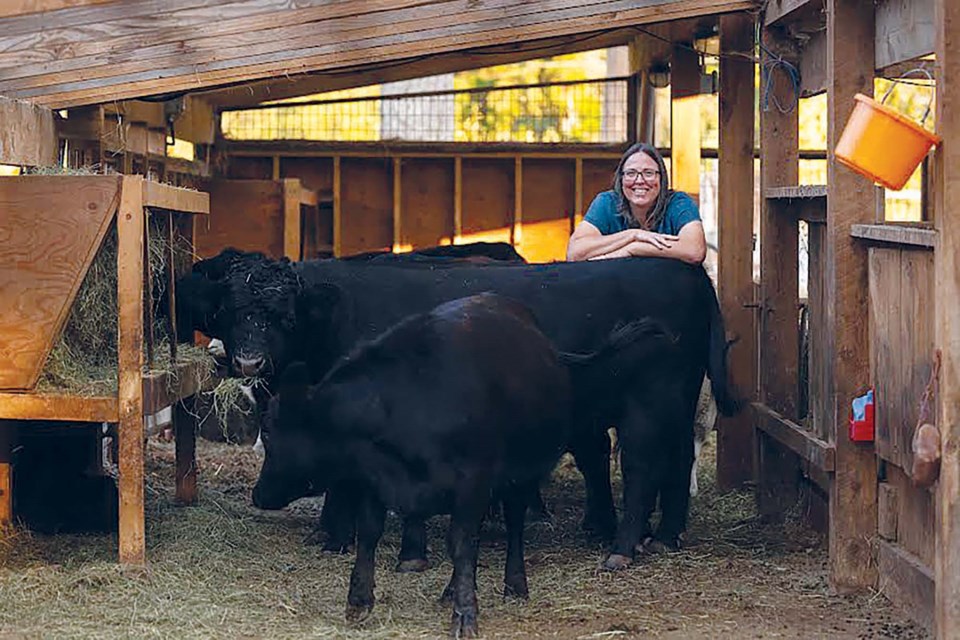We have many movers and shakers here in Elphinstone, and one of my favourite to speak to is Raquel Kolof. You can see Kolof getting her hands dirty at Hough Heritage Farm, which she owns and operates, producing a variety of farm goods but specializing in breeding beautiful heritage livestock. Her baby piglets make my cold heart melt. Kolof is also president of the Sunshine Coast Farmer’s Institute, where she is a passionate fighter for essential, practical farming and educating the public on our local food chains. Kolof wanted to share a piece about how important Regenerative Agriculture is to us right here at home:
Area E is fortunate to contain some of the most fertile farmland on the Sunshine Coast. Historically, Area E was home to many small farms that grew the berries for Empress Jams or produced lamb for family dinners. The Hough Dairy farm owned by Alice and Norman Hough was a cornerstone of the community and provided milk and ice cream to Gibsons until they sold to Bob and Mary Dory around 1967. The Houghs raised dairy cows and sheep on their large acreage between Pratt, Kearton and Hough Road. Bob and Mary Dory turned the dairy barn into a feed store and in 1971 sold their feed business to Olivia and Bob Wells who turned it into Quality Garden and Pet.
The Hough Dairy farmland has since been subdivided but some of the land still remains in the agricultural land reserve, allowing local families to continue the farming tradition in Area E. If you want to revisit the past, the old Hough Dairy barn is the Quality Garden and Pet store and the small house in the lot next door was Alice and Norman Hough’s Homestead.
When the Hough’s closed up shop in the late ’60s, it meant the end of a robust resilient local dairy and the loss of more of our fresh nutritious food supply to larger off-Coast conglomerates. No longer were locals able to shake the hand that feeds them.
As regenerative agriculture has been gaining popularity recently, it is important to understand this way of farming, raising both animals and plants in harmony with nature existed on the Coast long ago and is needed now more than ever. Unfortunately, most large scale farms grow one type of product and they separate livestock from the plants they nourish. Canada’s largest crops are tilled annual monocrops like wheat, canola, corn, soybeans and barley. These monocultures are the antithesis of regen ag.
The term regenerative agriculture first appeared in the 1980s but is deeply rooted in Indigenous cultures that practiced these time-honoured principles for millennia. It is a farming practice that focuses on soil health and biodiversity in order to reverse climate change and improve the water cycle. Regen ag does not rely on big corporations for costly inputs.
The five principles of regenerative agriculture:
1. Don’t disturb the soil. This means no tilling or toxic chemicals. Damaged soil releases carbon back to the atmosphere. One teaspoon of soil contains more living organisms than there are people in the world so leave the soil intact. We need to treat our soil as a living organism.
2. Cover the soil. Keep the soil armoured with plants, grasses, cover crops or at the very least mulch. Direct sun can kill bare soil and rain will wash away topsoil. Bare ground causes drought.
3. Maintain living roots. Roots feed the soil food web with carbon compounds. Perennial plants are ideal. Without living plants, you get more evaporation. Forty per cent of rainfall comes from land-based small water cycles.
4. Biodiversity is best. Soil life thrives on variety. Monocultures don’t exist in nature.
5. Integrate livestock, especially hooved herding herbivores. Animals are essential to regenerate land and are part of the carbon cycle, but most farms do not have enough acreage to keep livestock. Pastured poultry can do the job on small parcels.
But anyone can incorporate manure and compost into their garden to feed the soil microbiome.
While some corporations look to agritech to grow more food, regen ag is an accessible, affordable, inherently low-tech practice for growing nutritious food while leaving the land better than you found it. Technology will never outperform nature. “The answer is not more technology to overcome nature, it is understanding nature and working with it to restore balance,” said Dr. Hans Herren. Herren won the World Food Prize in 1995.
If you want to learn more, read Dirt to Soil by Gabe Brown or Call of the Reed Warbler by Charles Massey and watch the documentary Kiss the Ground on Netflix.
Luckily, Area E is blessed with many farms that practice the principles of regenerative agriculture, so it is easier than ever to support local and eat nutritious land healing food.
Thanks to Raquel, and if you have feedback or suggestions on topics in our neighbourhood, go ahead and email me at [email protected].



